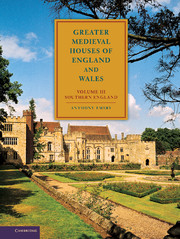Book contents
- Frontmatter
- Contents
- Acknowledgements
- List of abbreviations
- Introduction
- PART I THE THAMES VALLEY
- PART II LONDON AND SOUTH-EAST ENGLAND
- PART III SOUTH-WEST ENGLAND
- Appendix 5 Castles of south-west England: residential additions
- Appendix 6 South-west England: residential licences to crenellate
- Appendix 7 The architectural value of John Leland and the Buck brothers
- List of plates
- List of figures
- Index
- Index of houses in volumes I, II and III
Appendix 7 - The architectural value of John Leland and the Buck brothers
Published online by Cambridge University Press: 05 June 2012
- Frontmatter
- Contents
- Acknowledgements
- List of abbreviations
- Introduction
- PART I THE THAMES VALLEY
- PART II LONDON AND SOUTH-EAST ENGLAND
- PART III SOUTH-WEST ENGLAND
- Appendix 5 Castles of south-west England: residential additions
- Appendix 6 South-west England: residential licences to crenellate
- Appendix 7 The architectural value of John Leland and the Buck brothers
- List of plates
- List of figures
- Index
- Index of houses in volumes I, II and III
Summary
Throughout these volumes, constant reference has been made to the work of two primary topographical sources for late medieval England and Wales – the mid-sixteenth-century recorder John Leland and the mid-eighteenth-century artists Samuel and Nathaniel Buck. The former pioneered the practice of observation and direct inquiry in a sequence of travels across the Tudor countryside, while the latter made a pictorial record of over 400 medieval buildings at the point when their antiquarian value was being appreciated as much as their stimulation to romantic and picturesque sensibilities. Their architectural import, and in the case of the Buck brothers their accuracy, have been undervalued.
JOHN LELAND
John Leland (c. 1503–52) was a youthful polymath – poet, antiquarian archivist, royal chaplain, librarian, and humanist – before he was thirtyy ears old, when he received his royal commission to ‘search after England's Antiquities, and peruse the libraries’ of monasteries, cathedrals, and colleges for manuscripts of value (1533). The result is his Itinerary, a topographical compendium describing five journeys made between about 1539 and 1545, plus jottings and notes, most of them drawn up during his earlier visits to monastic libraries but some subsequent to his extended travels. The publication drawn from the manuscripts now held in the Bodleian Library, Oxford was initiallyedited byThomas Hearne and published in 1710–12, with his notes following in 1715.
- Type
- Chapter
- Information
- Greater Medieval Houses of England and Wales, 1300–1500 , pp. 697 - 700Publisher: Cambridge University PressPrint publication year: 2006



